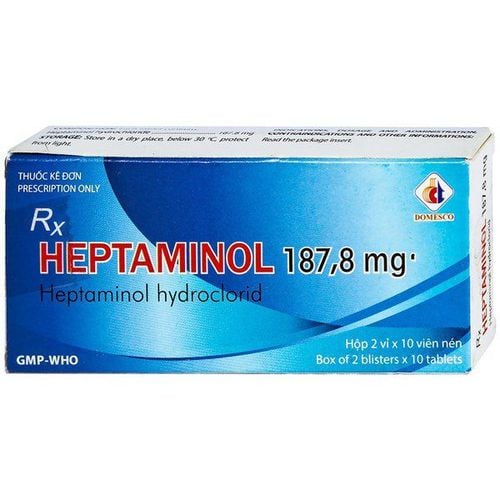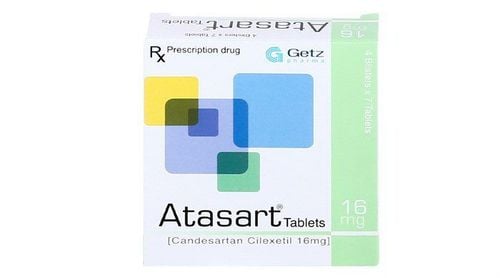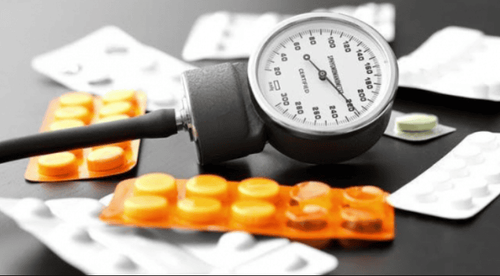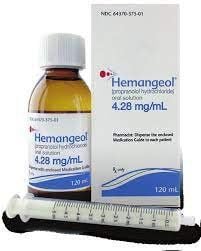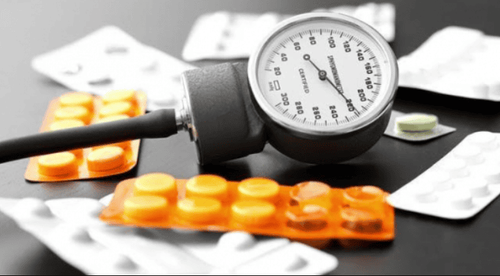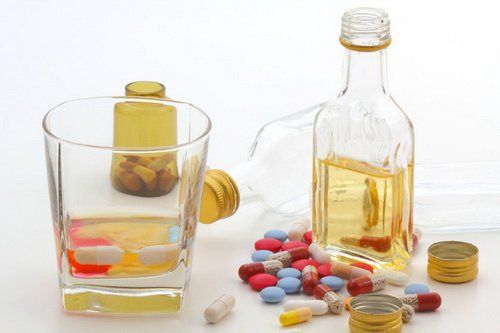This is an automatically translated article.
Antihypertensive drugs are selected based on a number of principles to ensure the return of blood pressure to the target blood pressure. Depending on the group of subjects, the recommended initiation of blood pressure medication varies.
1. What are antihypertensive drugs?
High blood pressure is a condition in which the blood pressure on the artery walls is higher than the allowable threshold. The patient was diagnosed with hypertension when resting blood pressure was measured on two different occasions with a systolic blood pressure greater than or equal to 140 mmHg and/or a diastolic blood pressure greater than or equal to 90 mmHg.
Blood pressure medications are drugs that work to keep blood pressure levels within the acceptable range to minimize the damage to the body caused by high blood pressure. Some drugs to treat high blood pressure are recommended to use, including:
Diuretics: A drug that increases the excretion of water and some electrolytes out through the urine, helping to reduce the volume of circulation. The most commonly used diuretics in the treatment of blood pressure are thiazide diuretics. In addition, there are loop diuretics, potassium-sparing diuretics. Calcium channel blockers: These are drugs that block the flow of calcium to help dilate blood vessels and lower blood pressure. These drugs are commonly used such as nifedipine, Amlodipine, nicardipine... ACE inhibitors: This drug inhibits the enzyme that produces Angiotensin II, which is a substance that increases blood pressure due to vasoconstriction. , keep water and salt. Inhibiting the production of this substance helps to lower blood pressure. Some drugs in this group include enalapril, coversyl(perindopril), captopril... AT1 receptor antagonists Angiotensin II: This is a drug that competes with Angiotensin II at the AT1 receptor, preventing this substance from binding. to its receptors to induce vasoconstriction. Some commonly used drugs such as telmisartan, losartan... Group of beta-blockers: This is a drug that inhibits the activity of beta-sympathomimetic receptors, thereby causing a decrease in heart rate and lower blood pressure. This drug is divided into non-selective beta-blockers and selective beta-blockers. Some other classes of antihypertensive drugs: Vasodilators, alpha blockers.
2. Principles of using antihypertensive drugs
Prescription high blood pressure drugs need to be used according to the doctor's prescription, do not arbitrarily buy drugs and drink indiscriminately because they are dangerous. To ensure that the selection and use of antihypertensive drugs are safe and optimal, the following principles must be followed:
2.1 Selection of antihypertensive drugs According to recommendations According to JNC 8, there are 4 drugs of choice for the treatment of hypertension, including: Diuretics, ACE inhibitors, calcium channel blockers, AT1 receptor antagonists.
For people with mild hypertension, isolated systolic hypertension, the preferred choice when new to use is a thiazide diuretic, a calcium channel blocker. For those with kidney disease, diabetes should choose an ACE inhibitor or an AT1 receptor antagonist. If patients over 75 years of age have kidney disease and are at risk of hyperkalemia, calcium channel blockers or diuretics should be used instead of these two classes of drugs. For patients with chest pain and tachycardia, a beta-blocker may be selected. Patients with heart failure should choose diuretics, calcium channel blockers. 2.2 Dose adjustment and drug combinations The selection, adjustment of doses, and combinations of drugs to achieve blood pressure goals.
Target blood pressure in patients 60 years of age or older without diabetes or chronic kidney disease, the JNC 8 target blood pressure level is < 150/90 mm Hg. For patients aged 18-59 years with no comorbidities, and in patients 60 years of age or older with diabetes, chronic kidney disease (CKD), or both, new target blood pressure that is < 140/90 mm Hg. Principle of drug dose selection:
First choose 1 drug with the lowest dose to monitor the effect. If the first medication does not bring blood pressure back to the target blood pressure, two options may be to increase the dose of that drug or to add another drug at a lower dose. Diuretics should be combined with the remaining drug classes such as beta-blockers, ACE inhibitors, calcium channel blockers, angiotensin II receptor blockers. Note do not combine ACE inhibitors and Angiotensin II receptor antagonists for one person For patients with grade 2 hypertension or higher with systolic blood pressure 160 - 179, diastolic blood pressure 100 - 109 mm Hg, patients at high risk of cardiovascular disease, it is necessary to combine 2 drugs at a low dose from the beginning. If the combination of two low-dose drugs has not been effective, at this time, the doctor will gradually increase the dose of one of the two drugs, until the dose is effective enough to bring blood pressure back to the target. If not achieved, a third drug can be added to bring blood pressure back to the target level. If the drug of choice is not effective at first and causes many side effects, you may need to switch to a different class of drugs. Long-acting antihypertensive drugs should be used, only need to be taken once a day. If you have taken a combination of drugs but still have not reached the target level, you need to be monitored and adjusted in the hospital, because you may have experienced resistant hypertension. 2.3 Drug treatment of hypertension should be combined with lifestyle measures The application of lifestyle changes should be applied to all patients to prevent disease progression, improve health and Reduce blood pressure, reduce the number of drugs needed ... Measures include:
Reasonable diet, ensuring enough potassium and trace elements: Reduce salt intake or reduce sodium intake. (< 6 grams of salt or 1 teaspoon of salt per day). Note that sodium is not only present in table salt, but also in MSG and other preparations. Eat more green vegetables and fresh fruits. Limit foods high in cholesterol and saturated fatty acids, reduce the amount of starch and sugar put into the body. Maintain a healthy weight with a body mass index (BMI) of 18.5 to 22.9 kg/m2. If you are overweight or obese, you should actively lose weight through exercise and diet. Try to maintain a waist circumference less than 90cm for men and less than 80cm for women. Limit alcohol, beer, stimulants: The standard is less than 3 standard drinks/day (men), less than 2 standard drinks/day (women) and a total of less than 14 standard drinks/week for men and less than 9 standard cups/week (women). Note that in 1 standard cup containing 10g of ethanol is equivalent to 330ml of beer or 120ml of wine, or 30ml of spirits. If possible, do not drink alcohol. Quit smoking or pipe tobacco altogether. This helps reduce the risk of many dangerous diseases. However, this can sometimes be difficult, you should have a community to support each other and get help from a doctor if needed. Increase physical activity at an appropriate level for each person: You should exercise, walk or exercise at a moderate level, regularly for about 30 to 60 minutes a day. Avoid anxiety or nervous tension; Attention should be paid to sleep and proper relaxation and rest. Avoid getting cold suddenly. Some hypotension has the potential to cause orthostatic hypotension, especially during the first period of drug administration. Therefore, you need to avoid getting up suddenly, so change your position slowly to avoid a sudden drop in blood pressure that can cause dizziness or fainting. In the process of taking the drug, try to avoid missing doses and do not suddenly stop taking the drug, because the risk of causing a very dangerous increase in blood pressure. Hopefully with the above information, you know the principles of using antihypertensive drugs and note when taking them.
Please dial HOTLINE for more information or register for an appointment HERE. Download MyVinmec app to make appointments faster and to manage your bookings easily.




